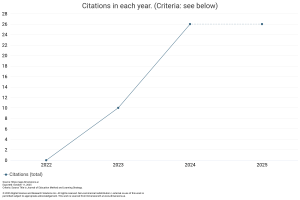Virtual Reality in Biology Assessment: Constructing and Standardizing an Achievement Test for Virtual Rat Dissection
DOI:
https://doi.org/10.59653/jemls.v3i02.1733Keywords:
biology achievement test, item analysis, reliability, validity and standardizationAbstract
This study presents a detailed process of designing and validating of the biology achievement test for class XI students. The investigator first framed 77 items from the class XI biology NCERT textbook. After writing test items, the researcher consulted subject experts to make sure the items were well-structured, free of language errors, and had the right difficulty level. Incorporating the expert suggestions, a preliminary draft of 80 test items was developed. This preliminary draft was then administered to 100 biology students in private CBSE schools in Chandigarh for item analysis. The difficulty value (DV) and item discrimination (DP) were established using Kelley's (1939) method. Based on item analysis, 38 items were retained in the achievement test. The average item difficulty of the test was calculated as 0.54, and the average item discrimination was 0.49. A high-reliability coefficient of .87 was obtained for the test. The test’s validity was supported through expert evaluation and content validation. The results showed that the biology achievement test is both highly reliable and valid for assessing class XI students' understanding of biology.
Downloads
References
Ahmad, S., Sultana, N., & Jamil, S. (2020a). Considerations for constructing and validating biology achievement test at secondary level. US-China Education Review B, 10(1). https://doi.org/10.17265/2161-6248/2020.01.002
Anderson, L. W., & Krathwohl, D. R. (2001). A taxonomy for learning, teaching, and assessing: A Revision of Bloom’s Taxonomy of Educational Objectives. New York: Longman.
Anderson, R. C. (1972). How to Construct Achievement Tests to Assess Comprehension. Review of Educational Research, 42(2), 145-170. https://doi.org/10.3102/00346543042002145
Bhagat. P., & Baliya, J.N. (2016). Construction and Validation of Achievement Test in Science. International Journal of Science and Research, 5(6), 2277-2280.
Ebel, R. L. (1965). Measuring Educational Achievement. Englewood Cliffs, N.J.: Prentice-Hall.
Hamilton, D., McKechnie, J., Edgerton, E., & Wilson, C. (2021). Immersive virtual reality as a pedagogical tool in education: a systematic literature review of quantitative learning outcomes and experimental design. Journal of Computers in Education, 8(1). https://doi.org/10.1007/s40692-020-00169-2
Malay, C.A., Fabia, J.N.V. & Santillan, E.P. (2023). Construction and Validation of Biology Assessment Test (BAT) for Junior High School Students. European Journal of Theoretical and Applied Sciences, 1(3), 134-139. DOI: 10.59324/ejtas.2023.1(3).13
Reen, F. J., Jump, O., McSharry, B. P., Morgan, J., Murphy, D., O’Leary, N., O’Mahony, B., Scallan, M., & Supple, B. (2021). The Use of Virtual Reality in the Teaching of Challenging Concepts in Virology, Cell Culture and Molecular Biology. Frontiers in Virtual Reality, 2. https://doi.org/10.3389/frvir.2021.670909
Romano, M., Bravin, A., Wright, M. D., Jacques, L., Miettinen, A., Hlushchuk, R., Dinkel, J., Bartzsch, S., Laissue, J. A., Djonov, V., & Coan, P. (2022). X-Ray Phase Contrast 3D Virtual Histology: Evaluation of Lung Alterations After Microbeam Irradiation. International Journal of Radiation Oncology Biology Physics, 112(3). https://doi.org/10.1016/j.ijrobp.2021.10.009
Singh, A., & Yadav, D. (2018). Construction and standardization of achievement test in Biology. International Journal of Research in Social Science, 8(3), 18-27.
Singh, D. K. (2020). Construction and Standardization of Biology Achievement test for Higher Secondary Students. Advances in Chemical and Applied Sciences, 3.
Sener, N., & Tas, E. (2017). Developing achievement test: A research for assessment of 5th grade biology subject. Journal of Education and Learning, 6(2), 254. https://doi.org/10.5539/jel.v6n2p254
Thompson, M., Uz-Bilgin, C., Tutwiler, M. S., Anteneh, M., Meija, J. C., Wang, A., Tan, P., Eberhardt, R., Roy, D., Perry, J., & Klopfer, E. (2021). Immersion positively affects learning in virtual reality games compared to equally interactive 2d games. Information and Learning Science, 122(7–8). https://doi.org/10.1108/ILS-12-2020-0252
Vani, T. & Shabana. (2018). Construction and Standardization of an Achievement Test of Biological Science for class IX Students. Int. J. Rev. and Res. Social Sci, 6(11), 12-14
Veronesi, G. (2017). ES 05.04 Minimally Invasive Surgery for Lung Cancer, including Robotics. Journal of Thoracic Oncology, 12(11). https://doi.org/10.1016/j.jtho.2017.09.123
Downloads
Published
How to Cite
Issue
Section
License
Copyright (c) 2025 Simmi Sarpal, Anita Nangia

This work is licensed under a Creative Commons Attribution-ShareAlike 4.0 International License.
Authors who publish with this journal agree to the following terms:
- Authors retain copyright and grant the journal right of first publication with the work simultaneously licensed under a Creative Commons Attribution-ShareAlike that allows others to share the work with an acknowledgement of the work's authorship and initial publication in this journal.
- Authors are able to enter into separate, additional contractual arrangements for the non-exclusive distribution of the journal's published version of the work (e.g., post it to an institutional repository or publish it in a book), with an acknowledgement of its initial publication in this journal.
- Authors are permitted and encouraged to post their work online (e.g., in institutional repositories or on their website) prior to and during the submission process, as it can lead to productive exchanges, as well as earlier and greater citation of published work (See The Effect of Open Access).
























